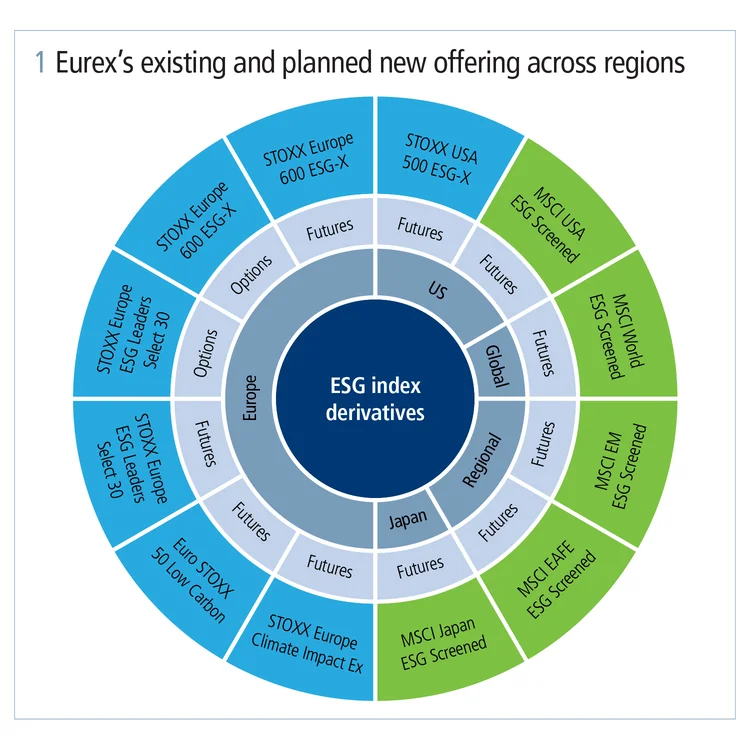
This article was paid for by a contributing third party.More Information.

Eurex takes ESG derivatives to a global level

Zubin Ramdarshan, head of equity and index product design, and Christine Heyde, product manager for environmental, social and governance (ESG) derivatives, Eurex, explore the firm’s decision to expand its range of ESG futures on European and global indexes to meet growing demand, and why driving a change of behaviour is top of its priority list
Amid growing concern for the future of our planet, demographic shifts and regulatory changes, environmental, social and governance (ESG) strategies are attracting increasing interest from investors across Europe and beyond. International derivatives exchange Eurex – as a frequent first mover in this space – firmly believes the tide is turning, and is expanding its range of ESG futures on European and global indexes to meet growing demand.
What is driving Eurex’s interest in ESG?
Zubin Ramdarshan: Customer demand. One responsibility of an exchange is to respond to customer demands. ESG continues to emerge as a consistent theme in conversations with members, and Eurex’s research process has backed this up.
In assets under management in the exchange-traded fund market, we saw a double-digit growth rate in the ESG strategies being launched at issuers. We also considered the volume of licences issued and feedback from index providers such as STOXX and MSCI – where the response was overwhelmingly positive.
ESG is being driven by the fundamental transfer of wealth to a younger, more environmentally conscious generation. It is top of the agenda for millennials – there’s a growing sense of responsibility for the planet’s future, which, in the financial industry, is creating the opportunity to lead by positive change. We’re trying to offer a range of instruments to manage sustainability risks that encourage this change and contribute to new investment behaviour via these alternatives.
We spend a lot of time on due diligence, understanding the methodologies and ensuring they are appropriate for our client base. As an exchange, we are responsible for setting the agenda and promoting it to a broader audience. As the first mover on ESG benchmarks, we need to make more people care and create a virtuous circle.
What’s the attraction of ESG derivatives, and what has been the feedback to date?
Christine Heyde: ESG derivatives provide asset managers with liquid and cost-efficient alternatives to manage undesired sustainability risks, trade longer-dated maturities and align their ESG investment mandates. Eurex has championed their development and set the stage for the various initiatives and launches that have occurred since.
In February 2019, Eurex launched the STOXX Europe 600 ESG-X index future – by far our most popular ESG derivatives contract – which surpassed 500,000 traded contracts with €720 million in open interest by the middle of December. Over half the flow originated from end-user asset managers and owners. We currently have around 30 different market participants using this contract and up to five market-makers providing prices to ensure liquidity. We followed this eight months later with the listing of the first exchange-traded ESG index options on a European benchmark – the STOXX Europe 600 ESG-X index options.
What does the recent expansion of Eurex’s ESG derivatives portfolio mean?
Zubin Ramdarshan: Scheduled to coincide with the March 2020 roll, to encourage and facilitate transfer to ESG benchmarks, Eurex will be launching six new ESG derivatives covering various regional and global benchmarks in two phases – first in February and then in March 2020.
First up is the launch of ESG futures on the STOXXUSA 500 ESG-X in February 2020, extending the toolkit of derivatives for asset managers focusing on the US. This will be followed by a family of ESG futures on MSCI indexes at the beginning of March, covering the US; emerging markets (EM); 21 developed markets, including Europe, Australasia and the Far East (EAFE), but excluding the US and Canada; Japan; and worldwide (see figure 1).

Why is Eurex listing new MSCI futures in those regions?
Christine Heyde: The introduction of these futures on key global, regional and local MSCI indexes means we have further extended our derivatives suite to offer sustainable-themed futures and options on leading global benchmarks. With an increasing proportion of investment practitioners viewing ESG as integral to their strategies, these new products provide members and buy-side firms with additional tools to implement sustainability-driven mandates.
Investors are already very familiar with indexes such as MSCI World and the respective composition universe. Therefore, it becomes relatively easy to switch to an ESG-compliant index version. A typical path taken with all our index products is to launch futures first, aiming to build liquidity in the market, followed by index options. If investors then wish to utilise the index options, the respective futures delta hedge instrument is already available.
CME and ICE are also launching ESG derivatives – how do you view the competition in this space?
Zubin Ramdarshan: Competition is always healthy – it validates market demand, and investors should have choice. As a pioneer in this sector, we’ve aimed to develop an ESG segment including European-focused ESG index derivatives as well as global and EM products. There are also plans to develop a full suite of products, from light-screening to best-in-class, to complement our more focused offerings such as low-carbon and climate impact.
What are the benefits of screened versions compared with best-in-class and other more complex models?
Christine Heyde: One thing we’ve learned is that simplicity is likely to win. We believe starting with the screened family of products, followed by a staged roll-out of more complex offerings, is the right approach given the current state of ESG awareness and maturity.
Negative ESG screening or exclusions, which filter out undesirable components from a familiar benchmark – such as controversial weapons companies, tobacco manufacturers or companies deriving revenues from thermal coal – offer a transparent and understandable approach, with a low tracking error to the respective index. Those exclusion criteria can be standardised irrespective of the scoring/rating agency used, ideally eliminating any inconsistencies across index construction methodologies.
Exclusion-based indexes such as those chosen by Eurex have been successful as they are easy to explain to customers, and there is usually no significant change to the risk/reward dynamic of the benchmark. The UN Global Compact principles have already formed a consensus on which companies should be excluded, so exclusion-based indexes represent a logical entry point to ESG and socially responsible themes.
Therefore, our initial launch is based around exclusions and screening, which is a relatively straightforward way to integrate ESG. In 2020, we will continue to consult clients to assess and anticipate appetite for more innovative ESG solutions.
Why ESG derivatives?
- Environmental, social and governance (ESG) mandates – ESG derivatives offer a flexible solution for asset managers with strict mandates to achieve ESG compliance.
- Cost efficiency – ESG derivatives are a liquid and cost-efficient alternative to incorporate ESG into investment strategies and manage undesired sustainability risks.
- Capital efficiency – ESG futures and options are eligible for portfolio margin offsets against other index derivatives, including dividend and volatility derivatives.
- Proven liquidity – Liquid derivatives with incentive schemes promote on‑screen price support.
- Simple, fast integration – ESG futures and options have the standardised Eurex equity index contract specifications for straightforward integration into existing trading infrastructures.
- Related to successful benchmarks – ESG futures and options are sustainable versions of established benchmarks such as STOXX Europe 600, MSCI World and MSCI Emerging Markets.
How important is liquidity?
Zubin Ramdarshan: Very important – we support and incentivise liquidity providers through a dedicated scheme where they fulfil quotation obligations in terms of minimum volume and spreads. Clients will often need liquidity in non-roll periods to rebalance their portfolios. This has been the case so far, as we have also seen open interest and volumes equally strong in non-roll months. Liquidity is driven by real customer demand – and one indicator of real customer demand is the level of transactions on Eurex agency accounts. We are pleased to see more than 50% of the contracts were generated on behalf of customers.
How do these products compare in terms of performance and cost?
Christine Heyde: When introducing this new derivatives segment to our members, it was important not to dramatically transform the benchmark performance while delivering a valid alternative to an ESG mandate. Having a cost-efficient product with a low tracking error was vital when deciding on the methodology. ESG futures are an additional instrument for customers to incorporate ESG into their investment strategies and manage undesired sustainability risks. As a standardised listed future, we offer a cost-efficient alternative to other delta-one solutions – such as a cash basket with the headache of multiple transaction fees or over-the-counter execution with a prime broker in a bespoke total return swap. From a capital efficiency perspective, customers have the potential to leverage our portfolio margining (Prisma) at Eurex and enjoy margin offset benefits.
How do you see the trend for ESG or sustainable investing evolving?
Zubin Ramdarshan: On the regulatory side, there’s tremendous activity at the European Union level – such as developing climate benchmarks and a common taxonomy. Clearer guidelines and details on regulation will help build momentum in terms of index and product development. Similarly, ESG reporting requirements will mean asset managers face greater pressure to invest in these areas and further drive volume in ESG products. In the equity market, exclusion from a particular benchmark means raising equity capital may become harder or more expensive for a company. Can the same change happen on the debt side? Data and pricing are always the challenges in constructing sufficiently liquid indexes in the fixed income space, though we do also expect ESG benchmarks on the fixed income side to become more prevalent.
To coincide with the March 2020 roll, Eurex will be launching six new ESG derivatives covering various regional and global benchmarks in February and March 2020.
Sponsored content
Copyright Infopro Digital Limited. All rights reserved.
As outlined in our terms and conditions, https://www.infopro-digital.com/terms-and-conditions/subscriptions/ (point 2.4), printing is limited to a single copy.
If you would like to purchase additional rights please email info@risk.net
Copyright Infopro Digital Limited. All rights reserved.
You may share this content using our article tools. As outlined in our terms and conditions, https://www.infopro-digital.com/terms-and-conditions/subscriptions/ (clause 2.4), an Authorised User may only make one copy of the materials for their own personal use. You must also comply with the restrictions in clause 2.5.
If you would like to purchase additional rights please email info@risk.net